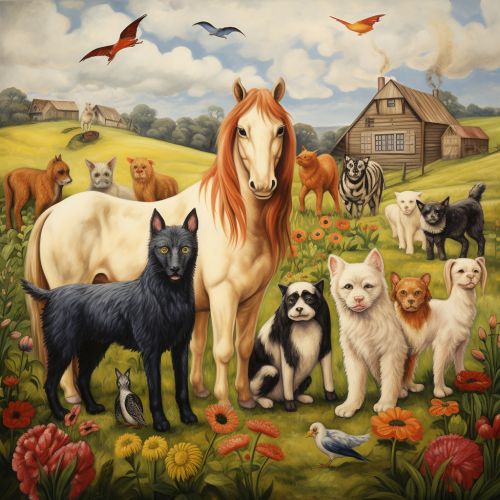Domesticated Animals
Introduction
Domestication is a sustained multi-generational, mutualistic relationship in which one organism assumes a significant degree of influence over the reproduction and care of another organism in order to secure a more predictable supply of a resource of interest, and through which the partner organism gains advantage over individuals that remain outside this relationship, thereby benefitting and often increasing the fitness of both the domesticator and the target domesticate. This complex process has resulted in the creation of various species of domesticated animals, which have been instrumental in the development of human societies across the globe.
History of Domestication
The domestication of animals is a process that began thousands of years ago. The first animals to be domesticated were likely dogs, which were used for hunting and companionship. Over time, humans began to domesticate other animals for a variety of purposes, including food, labor, and companionship. This process was not a one-time event, but rather a gradual process that occurred over many generations.
Types of Domesticated Animals
There are many types of domesticated animals, each with their own unique characteristics and uses. Some of the most common types include:
Livestock
Livestock animals are domesticated animals raised in an agricultural setting to produce labor and commodities such as meat, eggs, milk, fur, leather, and wool. Examples of livestock include cattle, pigs, sheep, goats, and poultry.
Pets
Pets, or companion animals, are domesticated animals kept primarily for a person's company or entertainment rather than as a working animal, livestock, or laboratory animal. Popular pets are often noted for their attractive appearances, intelligence, and relatable personalities. Examples of pets include dogs, cats, fish, and birds.
Working Animals
Working animals are animals, usually domesticated, that are kept by humans and trained to perform tasks. They may be close members of the family, such as guide dogs or other assistance dogs, or they may be animals trained to carry loads or to pull carts, such as horses, oxen, and dogs.


Role of Domesticated Animals in Society
Domesticated animals have played a crucial role in human society for thousands of years. They have been used for a variety of purposes, including food production, labor, transportation, companionship, and even religious rituals. The domestication of animals has also had a significant impact on the environment, as it has led to changes in land use, habitat loss, and biodiversity decline.
Food Production
One of the primary roles of domesticated animals in society is food production. Animals such as cows, pigs, and chickens are raised for their meat, while others, like cows and goats, are kept for their milk. Eggs from chickens, ducks, and other birds are also a significant source of food.
Labor and Transportation
Domesticated animals have also been used for labor and transportation for thousands of years. Horses, donkeys, and camels have been used to carry goods and people over long distances, while oxen and other large animals have been used to plow fields and perform other heavy labor tasks.
Companionship
Pets, or companion animals, provide emotional support and companionship to their owners. They can also serve practical roles such as hunting, herding, protection, and assistance to people with disabilities.
Impact of Domestication on Animals
The process of domestication has had a significant impact on the animals themselves. It has led to changes in their behavior, physiology, and morphology. Some of these changes have been beneficial, allowing the animals to thrive in a human-dominated environment, while others have been detrimental, leading to health problems and reduced survival in the wild.
Future of Domesticated Animals
The future of domesticated animals is uncertain. With the advent of industrial farming, many traditional breeds of domesticated animals are at risk of extinction. At the same time, advances in biotechnology have the potential to create new breeds of domesticated animals with enhanced traits. Regardless of what the future holds, it is clear that domesticated animals will continue to play a crucial role in human society.
